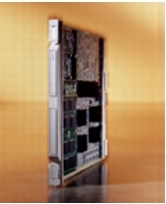|
• Configurable for trunk, Network-to-Network Interface (NNI), or UNI application
• Conformant to ATM Forum UNI 3.0, 3.1, and 4.0 and ITU-T I.361 and I.432 specifications
• Supports up to 16 CoS queues for IP and ATM traffic and includes all ATM Forum traffic-type services: ABR, unspecified bit rate (UBR), non-real-time variable bit rate (VBR-nrt), real-time variable bit rate (VBR-rt), constant bit rate (CBR); ABR supported with explicit forward congestion indicator (EFCI), RM marking, and explicit-rate stamping; supports ABR virtual source and destination
• Supports Integrated Local Management Interface (ILMI) 4.0
• Complies with standard usage parameter control (UPC) as specified by ATM Forum UNI 3.0 and 4.0, TM 4.1, and ITU-T I.371
• Supports early packet discard (EPD), Weighted Random Early Detection (WRED), and partial packet discard (PPD)
• Supports virtual circuit connections (VCCs) and virtual path connections (VPCs)
• Supports up to 128,000 connections
• Supports virtual path identifier (VPI) and virtual circuit identifier (VCI) range for VCCs and VPCs per UNI 3.1
• Supports per-virtual-circuit and per-virtual-path shaping and multipoint connections
Virtual trunks
• Supports a maximum of 128 virtual interfaces per module; the interfaces can be ports, trunks, or virtual trunks; each virtual interface supports 16 CoS queues
Cell buffering
• Supports 4 million cells of buffering to accommodate large traffic bursts and avoid network congestion and cell discard; suitable for TCP/IP traffic
Support for dynamic routing using PNNI 1.0
• Offers an automatic end-to-end connection management mechanism
• Deterministically allocates bandwidth and reroutes connections autonomously over optimum network paths
• Preserves service integrity during network failure
• Offers E.164 and network-service-access-point (NSAP) addressing
• Offers support for SVC and SVP and for SPVC and SPVP
• Offers quality-of-service (QoS) based routing
Enhanced call admission control
• A user-programmable Enhanced Call Admission Control (E-CAC) feature determines whether to admit or deny connections based on the requested QoS.
Statistics
• Statistics supported per connection
• Diagnostic statistics available per interface and CoS queues
Operation, administration, and management
• F4 to F5 fault propagation
• In-band diagnostics support using loopback cells
• In-band continuity check and automatic fault reporting for PVCs
• Loopback facility support for diagnostics and self-test purposes
|
